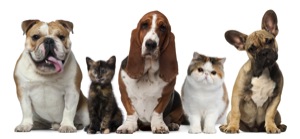
“The human-animal relationship is one of the cornerstones of a just and compassionate society.” Etched in the lobby wall of the San Diego Humane Society Central Campus, 5500 Gaines Street in Linda Vista, those words help explain why Americans are among the most avid pet owners on the planet.
Disney and Gary Larson’s Far Side cartoons personalized that relationship, and the American Pet Products Association estimates that the pet industry is a $52 billion annual business. With some data and real-life experience, let’s translate that into relevancy for the LGBT community.
According to a 2007 Harris Interactive/Witeck-Combs Communications survey, 71 percent of LGBT adults own pets, compared to 63 percent of heterosexuals. Interestingly, the percentage of LGBTs who own dogs and cats is exactly the same for both – 63 percent. (For heterosexuals, dogs clearly lead 71 percent-52 percent.)
Our community may seem much more dog owners because, honestly, how many do we see out walking their cats? Fourteen percent own fish, 5 percent birds and 20 percent “other,” which could include rabbits, ferrets, iguanas, hamsters or lizards that sell insurance.
A good friend once owned a pet cheetah before laws strictly limited such ownership!
The same survey found LGBTs and heterosexuals virtually identical (90 percent-89 percent) in considering their pet a member of the family. It is safe to say that while no one loves animals more than our community, really, virtually everyone does.
Think pets and the Humane Society comes to mind. Our local one in Linda Vista houses 800-1,000 animals, mostly dogs and cats of various ages, but also rabbits, birds and guinea pigs. Most are available for adoption. They have even had a magician’s dove, a domestic pigeon, turtles and a 7-foot python as part of a police investigation.
They also care for animals with medical issues or needing rehab. Kelli Herwehe at the Humane Society says that the No. 1 reason people seek a pet is companionship, particularly for singles. She explained that pets are “always there for you, having nothing to give but love.”
Pet-seekers range from seniors to young adults, split about evenly between people desiring a particular breed or type of dog or cat and those open to whatever animal with which they connect. Kelli said they have “a lot more” cats than dogs, largely due to overbreeding, and even have a separate kitten nursery.
The recent recession greatly increased the number of pets surrendered for adoption. Small dogs get adopted faster because their care is easier and apartment dwellers face fewer “landlord issues” with them.

Ninety percent of the cases of animal neglect that the Humane Society investigates prove to be simply people not understanding the proper care and attention required for their pet. So, they strive to educate and match people with an appropriate animal well-suited for their lifestyle and living conditions. A St. Bernard and a studio apartment? Not a match.
Kelli notices no great difference between heterosexuals and LGBTs who come looking for a pet. Still, the special bond we in the LGBT community have for animals seems especially strong in an affinity for those needing a home. They appear to call out “choose me” and touch our hearts.
Julia Szabo, writing on dogster.com in June 2011, gave a viable reason, “Perhaps gay people, having experienced intolerance, can relate especially well to misunderstood, overlooked, marginalized animals.”
The Humane Society of the U.S. reports that 21 percent of all pets are adopted; Ellen DeGeneres and others have made it a cause célèbre. My friends Joy and Kathleen foster-cared a mature Labrador mix named George, fell in love with him, then made him their own.
Attorney Al Smithson, a long-time supporter of the Feral Cat Coalition, daily feeds Golden Hill cats he has named. Yet, no one has taught me more about the attachment between adopted animal and human than close friend Jim Petersen.
A buff-colored tabby kitten entered his life as Jim and late partner Garry sat in their garden. Obviously needing food and care, their hearts went out to it, though they knew that, “If we fed it, it was ours.” They tried to keep it in the garage, until one day they noticed the door handle turning as the cat tried to gain entry to the house. From then on, it was a house cat and member of the family. Calling it a “cute little baby,” the name stuck.
Jim’s experience is not unique in our community. Everyone has those special moments and treasured stories of pets and their personalities, adding up to love. Baby now ventures outside but only under supervision and only to the property line to chase away a squirrel or other cat.
Oddly, dogs are welcome, because we all – and especially Baby – know that he “is not a cat.” He comes when you call him; loves people, boxes, riding in the car (on the dash), playing hide and seek and being vacuumed – literally.
Jim shares some of Baby’s most endearing behavior, “This is an amazing little creature with enormous intelligence. He knew when Garry was very ill with cancer and kept vigil on him for so long, laying beside him most of the time. When Garry passed, Baby sat at the bedroom door every evening and cried out for more than a month. He truly grieved. It let me know how I wasn’t the only one suffering the loss.” This is not so far-fetched. A new study reported in Science Daily suggests that dogs, indeed, are capable of understanding the human perspective.
Today, Baby is almost constantly at Jim’s side, keeping an eye on him, beginning the night sleeping beside him. And Baby is something of a local celebrity. Visitors, even those who don’t “like” cats, admit they come to see him. “And, oh yes, Jim,” they quickly add.

With the growth in the number of pets, society has become increasingly pet-friendly. While many public places limit access to those deemed as “service” or “therapy” animals, one may take their leashed dog shopping at Petco, PetSmart or pet shops or even, with common-sense limitations (leash, they don’t bite, you clean up after them), Home Depot or Lowe’s.
While few restaurants permit non-service dogs inside, a growing list of establishments allow or even welcome dogs to patio areas. Listings are available at bringfido.com or dogfriendly.com.
If you would like to add a “Baby” to your life, I highly recommend the Humane Society and their beautiful facility. They offer many services and classes, an area in which one may get acquainted with a prospective pet, plenty of helpful advice and volunteer opportunities. One thing is unmistakable: they absolutely love animals! The typical adoption fee ranges from $25 to $175. Check them out at sdhumane.org.
Pets are the paws that refresh us. Remember, when admiring your or others’ pets, they are very possibly feeling your compassion, sensing what you’re thinking, and aware of a relationship.












This is a great article by Lee Bowman — very informative and fun to read. Lee has a terrific wit and is a great punster — e.g., “the paws that refreshes” —
Go, Lee! — This article shows a lot of serious research and gives us useful resources. Lee is clearly an animal lover and his compassion and caring shows. Thank you, Lee —